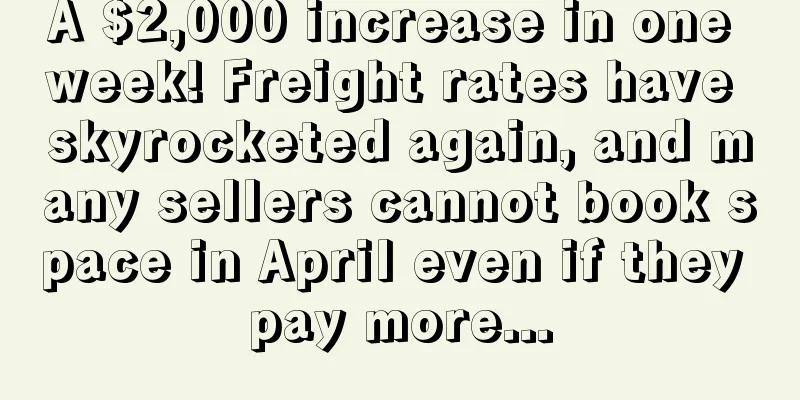Orders dropped by 70%, sellers: I’m so annoyed!

|
The hotter the weather, the cooler the orders.
Since entering June, sellers' sales have continued to fluctuate like an electrocardiogram. The situation continued until Father's Day, when some sellers' sales hit a new low, with individual orders falling by 70% and collapsing on multiple sites. While sellers are struggling with "declining orders", operating costs such as advertising fees are also continuing to rise, and many people are saying that it is difficult to continue.
As the big sale is approaching, competing platforms are once again rushing to take advantage of Prime Day in order to gain a large share of orders. Chinese e-commerce platforms such as TEMU, SHEIN, and TikTok are also using different strategies to grab traffic and orders, exacerbating the current situation of Amazon being "encircled and suppressed".
The situation of involution among sellers may escalate again. As foreign trade business cools, factories are closing down, and many large factories that have been operating in Shenzhen for decades have announced their dissolution. On the contrary, the threshold for cross-border e-commerce is gradually lowering, and more and more foreign trade companies are choosing to transform and accelerate their entry into the cross-border e-commerce market to share the pie.
It has declined again, and many sellers have poor sales
In June, the order volume of many sellers has recovered, but the good times did not last long. Some sellers said that since the May holiday, the order volume has been in a half-dead state, fluctuating up and down, and this situation has continued until June. In fact, this situation is not an isolated case. In recent times, the order situation of most sellers is almost similar to the curve of the electrocardiogram, and it continued until Father's Day, when the order volume directly fell to a new low.
“My orders dropped by half and I thought something went wrong,” a colleague said.
The order volume in June was already unstable, and it dropped by half on Father's Day. Many sellers complained about the poor order and the serious decline. Blogger @Amazon美刀 said, "The ranking has basically not changed, and the order has dropped by 30%. Father's Day is to blame." The voice of the decline in order volume once resonated with many sellers. One seller said with tears in his eyes, "I only have 30% of the orders left. The sales in the summer are like winter."
The hotter the weather, the colder the orders. Many sellers feel the same way. An industry insider reported that multiple sites including the United States had crashed. An account that had more than 100 orders the day before was halved the next day, leaving only 40-50 orders. Advertising was useless. It was really far from the truth.
In this regard, the common complaint among industry insiders is that Father’s spending power is low on Father’s Day. One colleague joked, “Men all over the world have less spending power than dogs?” In fact, this has been proven many times in the cross-border e-commerce market. The easiest people to make money in the world are women, followed by children, then pets, and finally men.
Some sellers secretly rejoiced that the traffic was good today and they successfully achieved a surge in orders. However, the reality of most sellers is that they cannot support the "order volume". Many sellers spend a lot of money on advertising in the hope of increasing product sales, but after increasing advertising budgets and bidding, the conversion rate has not improved, and some sellers' rankings have even dropped.
A group of sellers complained bitterly. Advertising fees are spent like water, but the conversion rate is low and the fees are ridiculously high. A seller complained to the editor: "The advertising fee for my category has soared to 4 US dollars per click. The advertising fee for new products has caught up with the sales. I am ready to give up." According to sellers' feedback, this situation is common in the low-unit-price market. For example, for a product priced at 6-10 US dollars, its cost per click can exceed 1 US dollar. It can be said that advertising expenses and sales are on par.
It seems that there are orders, but when you calculate the profit, it is almost completely eaten up. With the profit completely eaten up, do sellers have to stick to the old products? It is understood that some sellers are trying other promotion channels, such as off-site and big discount on-site, to break the current situation of unprofitable advertising.
Looking closely, Amazon has raised advertising fees quite a bit in recent years, which is a big part of the increased fees. Marketplace Pulse data shows that in June 2021, the average CPC for Amazon US ads was $1.16, an increase of more than 50% year-on-year. By September 2023, the CPC for Amazon ads had increased by 30% from the beginning of the year, and more than 50% year-on-year.
The continuous increase in advertising fees has directly led to a significant reduction in sellers' profits. Data shows that the average advertising fee that sellers need to spend accounts for 30% of the product price, and some even account for more. For this reason, although sellers complain repeatedly, they are powerless, after all, they have to spend money on advertising.
The decline in order volume has also exacerbated the "little thoughts" of some sellers. In order to save the order volume, some sellers began to lower the price of their products, hoping to win by volume. One seller complained: "I used to sell my product for $29.99, but now my peers have reduced the price to $9.99. I would be lying if I said I wasn't heartbroken."
I thought that only newbies could get the lowest price, but now old competitors have also started to offer low prices to increase sales. The seller said helplessly that his sales volume has been reduced from 20-30 orders to single digits. Seeing that costs are getting higher and higher every year, and prices are getting lower and lower, the word "profit" is almost unrecognizable.
In fact, the rising costs include not only advertising costs, but also logistics costs. The first-leg freight rates continue to rise. Freight forwarders are out of space, containers are abandoned, and orders cannot be received. Some sellers are facing shortages after their shipments are abandoned four times. Due to the congestion and the Red Sea crisis, many shipping companies have issued price increase notices for July. The prices of some routes have reached $10,000. Industry insiders predict that this wave of chaos may continue until August.
At the same time, various fees that are effective on the platform side are also constantly squeezing the profits of sellers. The largest of these is the warehousing configuration fee. Some sellers said that if the packaging of individual products is 1 cm different, the fee may differ by 0.4 USD. However, the profits of many products are very slim, so if the profit of the product is not good, it will be directly abandoned. Under the influence of multiple factors, more than half of the sellers in the first half of this year are very likely to fail to meet expectations in terms of revenue and profit. According to a media survey, in the first five months of this year, 77% of sellers saw a decline in revenue, and 40% of them saw a revenue drop of more than 30%.
As Prime Day is approaching, can sellers use it to reverse the situation of declining order volume and shrinking profits?
As competitors rush to launch Prime Day, can sellers still maintain their sales?
In the view of some sellers, the decline in order volume before Member’s Day has become the norm. This situation changes every year on Member’s Day, but whether it will remain the same this year is still an unknown. After all, competing platforms have launched a new wave of "sneak attacks."
Walmart, a competitor platform that used to be close to Amazon's Prime Day, started its Prime Week earlier this year, from June 17 to 23, three weeks earlier than Amazon's Prime Day. In addition, there is a Flash Deal that can be submitted in the background of this annual promotion of Prime Week, which spans from July 1 to July 31. This is equivalent to Walmart's promotion lasting more than a month in advance, which seems to be the first to consume consumer purchasing power. On platforms such as TikTok, Walmart's account has already begun to update related promotional videos, which has attracted a lot of attention.
Walmart got a head start before Prime Day, and other e-commerce platforms were not to be outdone and had already begun a battle to grab the market from the dimensions of sellers and consumers. Among them, the performance of the four little dragons going overseas was the most outstanding.
"Traffic has decreased and sales have fluctuated greatly" is the deepest feeling of most Chinese sellers. Last year, Amazon was the most affected, with its downloads falling 22% year-on-year. On the other hand, the downloads of Chinese e-commerce platforms SHEIN and TEMU showed an upward trend, increasing by 56% and 861% year-on-year respectively.
Even though Amazon’s current position is difficult to shake for the time being, it is undeniable that its consumers are being diverted by the four little dragons going overseas.
TEMU is one of the strong competitors. As of December last year, the number of independent visitors to TEMU reached 470 million, the same as AliExpress, ranking second in the world. TEMU, which was launched just over two years ago, is already regarded as a strong rival to Amazon. In an interview data, although only 6.4% of people trust TEMU, people still flock to TEMU to buy products, mainly household goods and accessories, beauty products and accessories, shoes and other products.
This has a lot to do with consumers downgrading their consumption and turning to lower-priced merchants to buy products. In fact, in order to cater to the current situation of consumers' downgrading, the low-price strategies of multiple platforms have become increasingly crazy. For example, Amazon launched a one-stop store Amazon Access to attract low-income customers; Walmart expanded its special product range to nearly 7,000 grocery items, so much so that some peers jokingly said, "From questioning TEMU, to understanding TEMU, and now starting to become TEMU."
TikTok has relied on its inherent social advantages to attract more sellers and consumers to join the market, including Anker and other major sellers. In May, TikTok's cross-border stores were gradually opened up, and no official invitation code was required. On June 13, TikTok once again updated the entry standards for the US site, canceling the 2 million entry standard threshold, which means that the requirements for Amazon sellers' store turnover were fully relaxed.
Soon after the news came out, many Amazon sellers were excited.
"Amazon's various fees are constantly rising, but sales have not changed much, so it's a good time to test the waters on TikTok," one seller lamented. In fact, many industry insiders have long discussed the $2 million threshold, believing that it is only a matter of time before it is cancelled. TikTok announced this news before the big promotion, and its purpose is self-evident. It can not only quickly attract a large number of sellers and brands to enter the market, but also attract more consumers to stay. On the other hand, TikTok may be trying to achieve its $17.5 billion goal.
According to data.ai , the average American user spends about 9.7 minutes on Amazon every day , while the average user spends about two hours on TikTok. Active users have obviously brought a surge in revenue for TikTok, with revenue in the US market expected to be about $7 billion in 2023.
The rise of Chinese cross-border e-commerce platforms overseas has also caused Amazon to have "concealed concerns". Regardless of the comments on the seller side, the consumer side has attracted enough traffic, especially TEMU, which has attracted more than 400 million visitors in two years. For this reason, Amazon has to continuously strengthen its moat and fight back by reducing logistics costs, reducing category commissions, and deepening its presence in industrial belts to compete for Chinese sellers, but it is obvious that the results are minimal.
In the first quarter of this year, Amazon's sales were $143.3 billion (mainly relying on AWS business), a year-on-year increase of 13%, while the sales in North America were $86.3 billion. Although its sales growth rate has rebounded, it is still slowing down and is not as fast as TEMU, TikTok and other platforms. Data shows that TEMU's revenue in the first quarter (including transaction service revenue) was 44.4 billion yuan, a year-on-year increase of 327%.
Not only that, the replacement rate of sellers on the Amazon platform is also high. Previously, a seller shared that he had collected some competing stores, most of which were stores with high order volume and excellent listings, and were worth learning from. There were about 400 stores, but currently only more than 60 stores are operating normally, and the rest of the stores are closed, with a closure rate of more than 80%.
Of course, it is not ruled out that some sellers have multiple stores and continue to operate under a different shell. It is estimated that hundreds of sellers have withdrawn from the Amazon platform. They started from scratch and entered Amazon, and made a lot of money after seizing the opportunity, but in the end they encountered a sluggish environment, and their growth bubble burst and they left Amazon. This is also a microcosm of many Amazon sellers. This situation also applies to large foreign trade manufacturers, and the ending is also regrettable.
A wave of large factories closing down, the foreign trade army enters the cross-border e-commerce track
Since the beginning of this year, a number of large factories have issued notices of closure and liquidation.
In early January, Shenzhen’s 30-year-old toy manufacturer Daqi Huasheng announced its closure. Its products were once exported to North America, Europe and other regions. Subsequently, Shenzhen’s 38-year-old electrical appliance manufacturer Xin’an Electric ceased operations. It had been a contract manufacturer for well-known brands such as Philips. In May, Weiya Electronics and Weiqun Precision Machinery announced their closures one after another. In June, the billion-level e-cigarette company Just announced its closure due to overdue payments from foreign customers.
It is not difficult to see that a major factor in the closure of the industry's leading manufacturers is the lack of orders, which undoubtedly reflects the difficult foreign trade environment. Under the influence of factors such as trade frictions, rising raw material costs, and reduced global demand, the market has become saturated and orders have been reduced again and again. In addition, some large manufacturers still stick to traditional manufacturing and have not formed their own competitive advantages. They are also easily eliminated by the market. One foreign trade boss bluntly said, "The cost of factory buildings and labor has increased dramatically, and operating losses have intensified. I simply chose to withdraw and sell millions of goods in the live broadcast room."
On the other hand, as the entry threshold of cross-border e-commerce is lowered, more and more traditional foreign trade companies are seeking to transform into cross-border e-commerce in an effort to get rid of operating losses.
Take Yiwu, a small commodity city, for example. Since April this year, the number of new merchants in Yiwu on Alibaba International Station has increased by 77.5% year-on-year. For this reason, the platform has also set up a special industrial zone here. Most of the merchants who have entered the cross-border e-commerce field are from Futian District 3, Xingzhong Community and Beiyuan. Most of them are mainly engaged in scarves and accessories. In addition, this year, platforms including AliExpress, International Station and TEMU have launched semi-hosting models, which also provides opportunities for these traditional foreign trade people to enter cross-border e-commerce.
A seller of hairpins said that due to the long payment period and great pressure of advance payment in traditional foreign trade, he gave up the agent purchasing model and turned to the cross-border e-commerce field. After some investigation, he finally decided to sell biodegradable hairpins and hair accessories to the European and American markets. The profit is higher under the small order and quick response model. Now the scale of his foreign trade has expanded to more than 40 million yuan.
The opportunities in Yiwu market are imaginable. With traditional domestic trade as its starting point and foreign trade as its icing on the cake, the inherent advantage of Yiwu as a commodity city gives it a natural advantage in the field of cross-border e-commerce. Since January this year, e-commerce giants including TikTok and SHEIN have gathered to hold several summits in an attempt to introduce Yiwu foreign trade people into the cross-border e-commerce industry. From offline to online, Midi Technology is also an example. It has tried cross-border e-commerce through the full-hosting model of SHEIN, TEMU and other platforms. While establishing its own brand, it has also tapped a group of precise customers.
In the eyes of foreign trade people, the transformation to cross-border business allows their products to be directly sold to global C-end consumers, get rid of the crisis of order interruption, and obtain healthier profit margins and cash flow. A seller who has successfully transformed said that before, foreign trade could achieve a gross profit of 15%-20%, but in the cross-border e-commerce channel, it can be increased to 40%, and the payment cycle is basically maintained at once every two weeks.
Although the overall environment faces many uncertainties, foreign trade sellers who have transformed into cross-border e-commerce have not felt too much pressure. Seller Xiao Lin said, "We have made plans. Traditional orders account for only one-tenth of the company's orders, and the rest are mostly orders received through platforms such as Amazon and AliExpress." Self-created brands are becoming more and more popular among overseas individual customers, and B2C sales are increasing, and it is expected to grow by about 1.5 times this year.
As we all know, the integration of industry and trade has cost advantages, which is also a major advantage for most factory-type sellers to enter cross-border e-commerce platforms such as TEMU. In the competition with peers, factory-type sellers can keep the price of the same product to the lowest. "90% of the foreign trade companies around me are considering transformation and transferring offline business to online," said a foreign trade transformation cross-border e-commerce seller.
Many sellers have a deep understanding of the fact that "overseas markets have huge profit margins". A workwear shoe manufacturer admitted that its products can be priced at an average of US$100 or even US$200 on Amazon, but the same product can only be sold for more than RMB100 in China, or even 50 or 60 yuan, and the sales volume is not as good as overseas. Obviously, the attraction of pursuing profit margins is huge.
For sellers who are transforming, those who have experienced it give the experience that "you must create your own brand". Compared with factory OEM production, there are too many benefits to creating a brand. Brand premium, increased consumer trust, and sales growth are all benefits after the brand is established.
However, sellers who are transforming should also pay attention to the fact that cross-border e-commerce and traditional foreign trade operate in very different ways. Unlike factories that directly produce products according to customers, cross-border e-commerce not only needs to control products, but also needs to set up operations positions to directly face C-end consumers. Regardless of which platform you transform and cultivate, I wish all cross-border workers a boom in orders. Unit quantity foreign trade Temu |
<<: AliExpress opens the overseas sales channel for cat and dog food!
Recommend
What is Altacrest Capital? Altacrest Capital Review, Features
Altacrest Capital is a Dallas-based private equity...
Russia's e-commerce scale reached 282.8 billion yuan in 2020, with clothing cross-border orders being the highest
AKIT said that in 2020, Russians spent a total of...
AliExpress semi-trusteeship grows rapidly, opening a cross-border warehouse in Southwest China for the first time
On April 16, AliExpress and Cainiao jointly annou...
Another Shenzhen brand has emerged from the red ocean track
In recent years, more and more young people aroun...
India's Diwali e-commerce transaction volume reached US$9.2 billion!
India has been plagued by the epidemic for a long...
What is OuiTrust? OuiTrust Review, Features
<span data-docs-delta="[[20,{"gallery"...
What is Doggy Treat Box? Doggy Treat Box Review, Features
Doggy Treat Box is a subscription-based e-commerc...
What is Gratisography? Gratisography Review, Features
Gratisography is a collection of free high-quality...
DSK online sales up 120%! Demand for home fragrances on the rise in Australia
Australian home fragrance retailer Dusk Group ( D...
What is Gumtree? Gumtree Review, Features
Gumtree is a British online classifieds and commu...
Amazon seller backend interface has been complained about...
Today, the editor saw a post in the seller forum ...
Zhejiang's post-90s generation goes overseas and ranks first in sales worldwide
Yushu Technology attracted widespread attention d...
ShopAstro, a cross-border e-commerce platform, completes USD 10 million Series A financing
As the big sellers of products are on the road to...
Regarding peak season traffic, Amazon has new moves!
The peak season at the end of the year is the gol...
What is PS Certification? PS Certification Review, Features
"PS Certification" is the abbreviation o...









